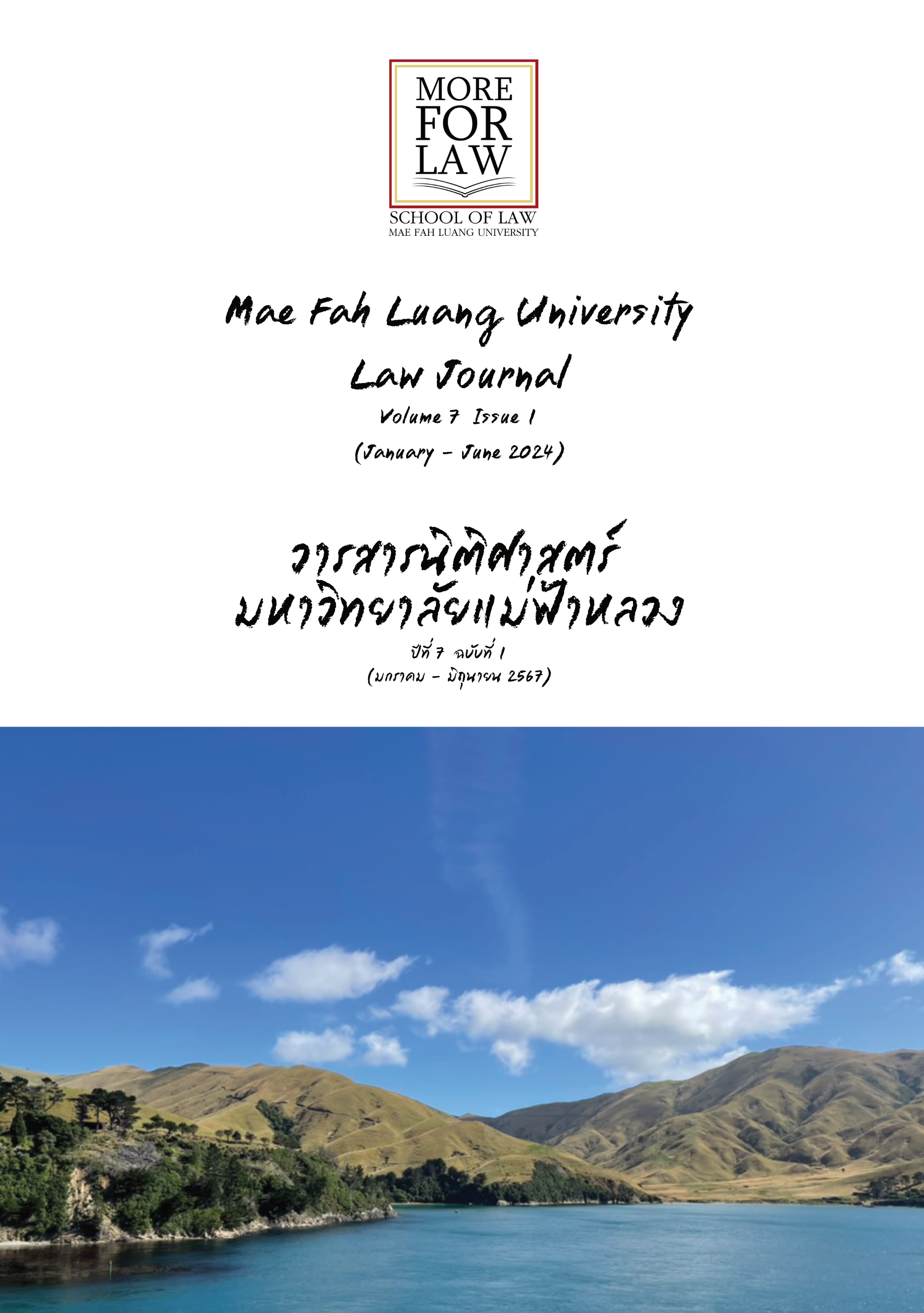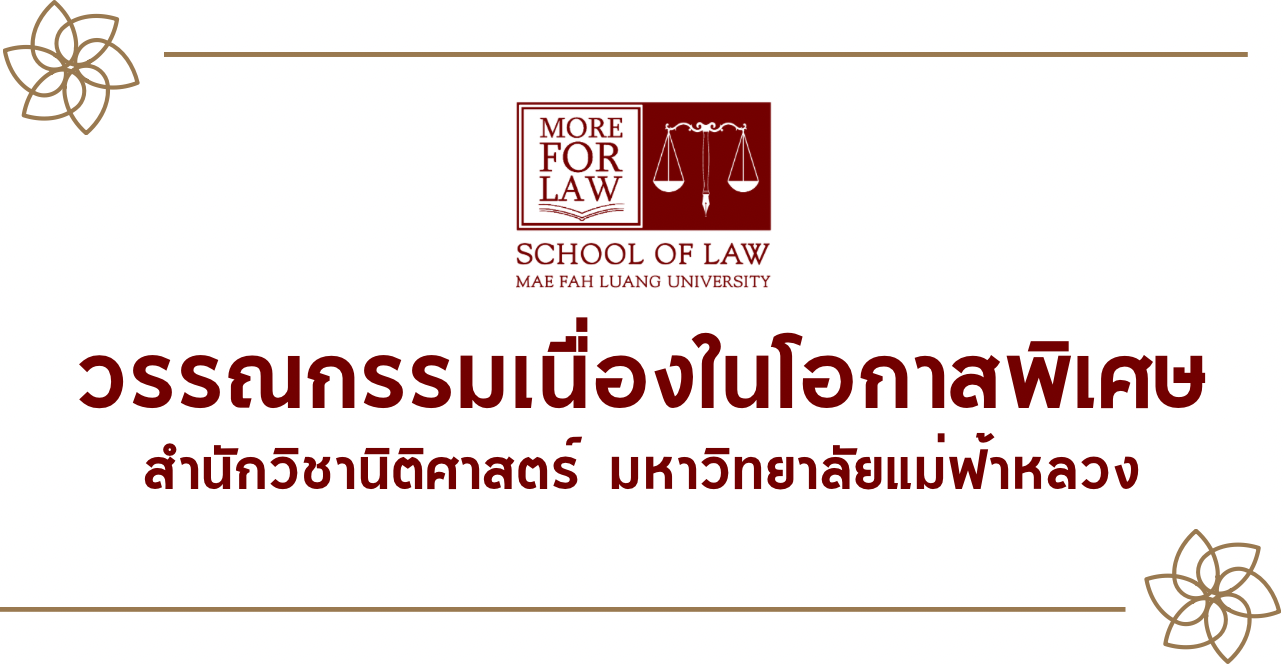Land Boundary Dispute between Thailand and Cambodia: Legal Status on the Annex I Map Line of the Case Concerning The Temple of Phra Vihear
DOI:
https://doi.org/10.14456/mfulj.2024.4Keywords:
Annex 1 Map, Thai-Cambodian Border, Preah Vihear Temple, MapAbstract
International boundaries are crucial in indicating the existence of a state’s defined territories and determining their sovereignty extent. The delimitation of boundaries and the mechanisms for establishing boundary lines are therefore important between neighbouring independent states. In general, boundary delimitations usually appear as written in the form of a treaty or other international agreement that has a Joint Commission to determine or create a map to show the boundary line. Therefore, the map is essential in matters of boundary. A specific map was accepted as part of the treaty or other international agreements. Normally, maps are presented to international courts when boundary disputes arise. However, courts often weigh the value of map evidence based on its origin or reliability. The case of the land boundary between Thailand and Cambodia is not different from the general boundary principle. The boundaries of the two sides were established by several boundary treaties between Siam and France. The Treaty of 1904 and the Treaty of 1907 were important treaties used as a survey and demarcation mechanism to resolve intermittent border disputes between Thailand and Cambodia until today. One of the important land boundary problems is where the boundary line is in the Dong Rak Mountain area. The view from the Thai side clearly shows that the watershed as it appears in Article 1 of the Treaty of 1904 is a boundary line. On the contrary, Cambodia has taken the line in the Annex 1 map in the Preah Vihear case as the boundary line based on the interpretation of the court's judgment that both sides have accepted the line on the map. The two sides' radically different views of the boundary line have led to a territorial dispute and military clashes along the border, which led to the submission of the case to the International Court of Justice for another term in the request for interpretation case. However, in the interpretation case, the Court limited disputes between the parties to sovereignty over the Preah Vihear area. The Court has brought the matter to attention, but it is just one aspect of the reasoning. The Court has not made a definitive ruling on the legal status of the lines. Consequently, the lines on the Annex 1 map remain unclear and are subject to the interpretation of each party involved.
The researcher concluded that the line on the Annex I map was a unilateral act of France, which was thereafter recognized by Cambodia as a successor to France regarding the frontiers. This map has never been officially and expressly recognized by the Thai government as a borderline between the two sides. The Court shall not infer from vague and controversial conduct that Thailand has accepted a map or lines on it through interpretation without the express consent of the parties. The Court considers the value of the line on the map greater than the express provision of the treaty. Therefore, the map and line on the map have no value as evidence and are not legally binding.
Downloads
References
กรมสนธิสัญญาและกฎหมาย, ประวัติศาสตร์ของการเจรจาในการขึ้นทะเบียนปราสาทพระวิหารเป็นมรดกโลกของยูเนสโก, พฤศจิกายน 2011.
กรมสนธิสัญญาและกฎหมาย, รายการเอกสาร เรื่อง ผลการกระประชุมคณะกรรมาธิการเขตแดนร่วมไทย-กัมพูชา (Joint Boundary Commission-JBC), สิงหาคม 2553.
กระทรวงการต่างประเทศ, ข้อมูลที่ประชาชนไทยควรทราบเกี่ยวกับกรณีปราสาทพระวิหารและการเจรจาเขตแดนไทย-กัมพูชา, 2554.
กระทรวงการต่างประเทศ, คำพิพากษาศาลยุติธรรมระหว่างประเทศ เมื่อวันที่ 11 พฤศจิกายน ค.ศ. 2013 ฉบับภาษาอังกฤษพร้อมคำแปลภาษาไทย, พิมพ์ครั้งที่ 1, กรกฎาคม 2557.
จันตรี สินศุภฤกษ์, กรณีพิพาทปราสาทพระวิหาร:บริบททางกฎหมายและการเมือง, พิมพ์ครั้งที่ 1, ( กรุงเทพฯ: นิติธรรม, 2557).
ชาญวิทย์ เกษตรศิริ, ประมวลสนธิสัญญา อนุสัญญา ความตกลง บันทึกความเข้าใจ และแผนที่ ระหว่างสยามประเทศไทยกับประเทศอาเซียนเพื่อนบ้าน : กัมพูชา-ลาว-พม่า-มาเลเซีย, พิมพ์ครั้งที่ 1, (กรุงเทพฯ: มูลนิธิโครงการตำรางสังคมศาสตร์และมนุษยศาสตร์, 2554).
บวรศักดิ์ อุวรรณโณ, แฉเอกสารลับที่สุด ปราสาทพระวิหาร พ.ศ. 2505-2551, พิมพ์ครั้งที่ 2, (กรุงเทพฯ:มิติชน, 2551).
ประสิทธิ์ ปิวาวัฒนาพาณิช, ศาลโลก-ศาลประจำอนุญาโตตุลาการกับข้อพิพาทระหว่างประเทศ, พิมพ์ครั้งที่ 1, (กรุงเทพฯ: มูลนิธิโครงการตำราสังคมศาสตร์และมนุษยศาสตร์, 2554).
พวงทอง ภวัครพันธุ์ ไอดา อรุณวงศ์ พงษ์เลิศ พงษ์วนานต์ (แปล),ธงชัย วินิจกุล, กำเนิดสยามจากแผนที่ประวัติศาสตร์ภูมิกายาขิงชาติ, พิมพ์ครั้งที่ 1, (กรุงเทพฯ: ภาพพิมพ์,2556).
เพชรณพัฒน์ ศรีวุทธิยประภา, หลักกฎหมายสนธิสัญญาตามอนุสัญญาเวียนนาว่าด้วยกฎหมายสนธิสัญญา, (กรุงเทพฯ: โรงพิมพ์เดือนตุลา, 2560).
มหาวิทยาลัยสุโขทัยธรรมาธิราช, เอกสารการสอนชุดวิชากฎหมายระหว่างประเทศ, พิมพ์ครั้งที่ 17, (กรุงเทพฯ: มหาวิทยาลัยสุโขทัยธรรมาธิราช, 2558).
โรม บุนนาค, เขาพระวิหาร ไทยเสียดินแดนครั้งสุดท้าย, (กรุงเทพฯ : สำนักพิมพ์สยามบันทึก, 2551).
สุวิทย์ ธีรศาสวัต, เบื้องลึกการเสียดินแดนและปัญหาปราสาทพระวิหาร จาก ร.ศ.112 ถึงปัจจุบัน, (กรุงเทพฯ: พิมพ์ดีจำกัด, 2553).
อัครพงษ์ ค่ำคูณ, เขตแดน พรมแดนและชายแดนระหว่างประเทศไทย-กัมพูชา, พิมพ์ครั้งที่ 1, (กรุงเทพฯ: มูลนิธิโครงการตำราสังคมศาสตร์และมนุษยศาสตร์, 2556).
Alec McEwen, The Demarcation and Maintenance of International Boundaries, A paper prepared for the Canadian Commissions of the Canada/United States International Boundary Commission, July 2002.
Guenter Weissberg, Maps as Evidence in International Boundary Disputes: A Reappraisal, The American Journal of International Law, Vol. 57, No. 4, (October 1963).
H. Lauterpacht, Oppenheim’s International law, Vol. I, (London: Longmans Green and Co.,1985).
Hyung K. Lee, Mapping the Law of Legalizing Maps: The Implications of the Emerging Rule on Map Evidence in International Law, Washington International Law Journal, Volume 14, Number 1, (January 2005).
Keith Highet, Evidence, the Court, and the Nicaragua Case, The American Journal of International Law, Vol. 81, No. 1, (1987).
L. Oppenheim, International Law, (London: Stevens & Sons Ltd, 1945).
Malcom Anderson, Frontiers: Territory and State Formation in the Modern World. (Oxford: Polity Press, 1997).
Sir Henry McMahon, International Boundaries, in Journal of the Royal Society of Arts, vol. 84 (May 1936).
Yearbook of International Law Commission, Draft Article on the Law of Treaties with Commentary adopted by the International Law ,Commission at its 18th Session, 1966, vol.II.
Durward v. Sandifer, Evidence before International Tribunals, 2d edition,(Charlottesville : University Press of Virginia, 1975).
Downloads
Published
How to Cite
Issue
Section
License
Copyright (c) 2024 Mae Fah Luang University Law Journal

This work is licensed under a Creative Commons Attribution-NonCommercial-NoDerivatives 4.0 International License.





